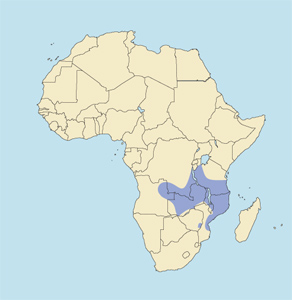 |
Alcelaphus lichtensteini
Bubalo de Lichtenstein (Sp), Konzi, Lichtensteins Kuhantilope (G), Bubale de Lichtenstein (F), Lichtenstein se hartbees (Af). Named after German naturalist W. H. C. Lichtenstein (1780-1857), at one time director of zoology at the Berlin Museum.
DESCRIPTION Shoulder height 47-48 inches (119-122 cm). Weight 280-320 pounds (127-145 kg).
The Lichtenstein hartebeest is a smaller hartebeest, with a very short and wide frontal pedicel, and horns that appear to have been crumpled into the shape of the letter S. The shoulders are higher than the hindquarters, so the back slopes downward. The upper body is reddish brown, the flanks a lighter tan, and the rump whitish. There is a dark stripe on the front of the legs. The horns (both sexes), are ringed, very wide and flattened at the base, and relatively short and thick throughout. They curve outward and upward, then sharply forward and inward at an angle of about 45 degrees, then finally backward, with the tips more or less parallel. Females are similar to males, but a little smaller and with smaller horns.
BEHAVIOR Gregarious, living in small family herds of 5-10 with a dominant bull; however, the herd is led by a female in case of danger. Other males form small bachelor groups, and old bulls may be solitary. Males are territorial, maintaining their territories year-round, marking the boundaries by horning the earth and rubbing their preorbital glands on the ground, and fighting off other males. A single young is born July-August after eight months gestation. Lifespan may be up to 20 years.
Both diurnal and nocturnal, active much of the day and night, though resting in cover during the heat of the day. Feeds mainly on grasses, and drinks water daily. Sedentary in its habits. A very fast runner.
HABITAT Savanna (Brachystegia) woodland and grassland.
DISTRIBUTION Northeastern Angola, southeastern Congo (K), western and southern Tanzania, most of Zambia, parts of Malawi, locally in southeastern Zimbabwe, and northern and central Mozambique.
In South Africa, they formerly occurred in the northeastern Transvaal, but were shot out about 90-100 years ago. Recently reintroduced in Kruger National Park and on private land in the Transvaal.
TAXONOMIC NOTES Several biologists regard the Lichtenstein hartebeest as a subspecies of common hartebeest; however, we elect to follow the majority, who consider it a full species.
|





